-
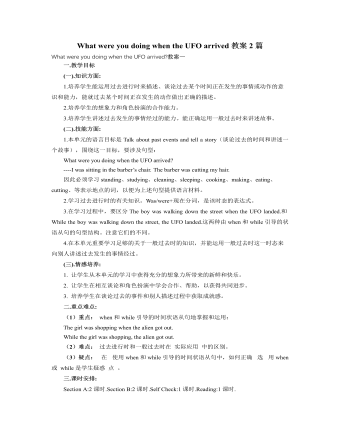
人教版新目标初中英语八年级下册What were you doing when the UFO arrived教案2篇
(一).知识方面: 1.培养学生能运用过去进行时来描述、谈论过去某个时间正在发生的事情或动作的意识和能力,能就过去某个时间正在发生的动作做出正确的描述。 2.培养学生的想象力和角色扮演的合作能力。 3.培养学生讲述过去发生的事情经过的能力。能正确运用一般过去时来讲述故事。 (二).技能方面: 1.本单元的语言目标是Talk about past events and tell a story(谈论过去的时间和讲述一个故事),围绕这一目标,要涉及句型: What were you doing when the UFO arrived? ----I was sitting in the barber’s chair. The barber was cutting my hair. 因此必须学习standing、studying、cleaning、sleeping、cooking、making、eating、cutting、等表示地点的词,以便为上述句型提供语言材料。2.学习过去进行时的有关知识。Was/were+现在分词,是该时态的表达式。 3.在学习过程中,要区分The boy was walking down the street when the UFO landed.和While the boy was walking down the street, the UFO landed.这两种由when和while引导的状语从句的句型结构。注意它们的不同。
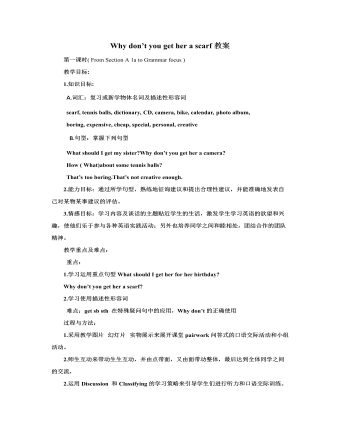
人教版新目标初中英语八年级下册Why don’t you get her a scarf教案
教师带领学生复习有关描述宠物的词汇,采用教师提问学生回答的方进行。如:T:What animals do you think would be good pets?What animals do you think would be bad pets?What do you think are good animals for a six-year-old child?然后学生进行 pairwork 练习。Task two: 师生互动,学习探究 1、播放3a部分的录音,引导学生一边听录音,一边跟读。2、通过听录音学生回答以下问题:Why do you think pot-bellied pigs are popular?What are the advantages and disadvantages of keeping such a pet?教师对学生的回答进行及时点评。3.学习范文,学习重点短语,为下步的模仿写作提供语言素材。T :1. )Have you ever kept a pig as a pet?Do you like pigs? St.:No.…Why don’t you like to keep a pig? St: No.They’re too dirty and lazy(Do you know in some foreign countries like Hollyland, Australia,pigs are the most popular pet.there’s a kind of pig.(图)it has an interesting name? it ‘s called a pot-bellied pig.) Now,let’s learn an article about this kind of interesting pet.2.)play the tapeSt.:Listen and repeat3.)show some Qs on computer(本子St.: read silently,then answerthe Qs(本子)4.)Ask ss. Close book and retell this passage.(what is a pot-bellied pig? Is it a good or bad pet? ) St.: retell it to each other“A pot –bellied pig is a popular pet now…”5.read the article together.St.:.practice reading
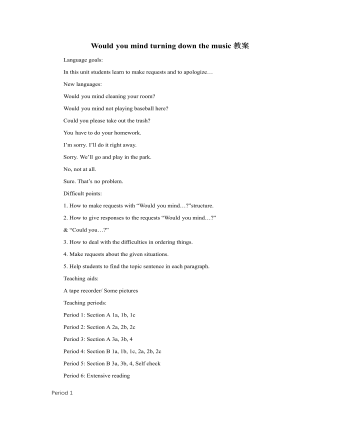
人教版新目标初中英语八年级下册Would you mind turning down the music教案
Step 4. Group work (4)1. Ask a pair of students to read the dialogue. Say, This activity provides speaking, listening and writing practice using the target language.2. Ask students to complete the work in groups.3. Check the answers with the whole class. 4. Explain some of the language points. Step 5. Word review (Self check 1)1. Ask students to read the words and the phrases given. 2. Fill in the blanks with proper forms of these words to complete the sentences. 3. Check the answers with the whole class. Homework:Do activity 2 on page 57 after class. Period 6Teaching aims: 1. Teach vocabulary words and the useful expressions. 2. Enable the students to learn etiquette in different culture. 3. Help the students learn how to behave politely in public places and in daily life. Teaching procedures:Step 1. RevisionHelp students to review the function of making requests through a free talk. Then lead them to the topic of etiquette. Explain the meaning of etiquette. Or, ask students to look it up in the dictionary. Step 2. Pre-reading (Section 1)1. Ask students to read the picture and make a list with their partner about how many rules of etiquette can be seen being broken.
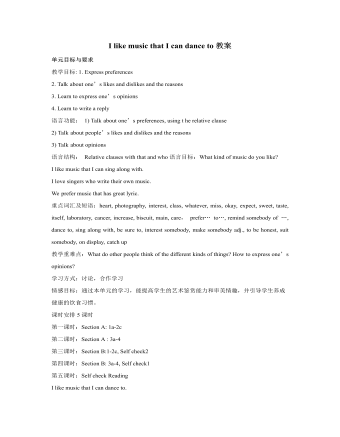
人教版新目标初中英语九年级上册I like music that I can dance to教案
教学目标: 1. Express preferences2. Talk about one’s likes and dislikes and the reasons3. Learn to express one’s opinions 4. Learn to write a reply 语言功能: 1) Talk about one’s preferences, using t he relative clause2) Talk about people’s likes and dislikes and the reasons3) Talk about opinions语言结构: Relative clauses with that and who语言目标:What kind of music do you like?I like music that I can sing along with.I love singers who write their own music.We prefer music that has great lyric.重点词汇及短语:heart, photography, interest, class, whatever, miss, okay, expect, sweet, taste, itself, laboratory, cancer, increase, biscuit, main, care, prefer… to…, remind somebody of …, dance to, sing along with, be sure to, interest somebody, make somebody adj., to be honest, suit somebody, on display, catch up教学重难点:What do other people think of the different kinds of things? How to express one’s opinions? 学习方式:讨论,合作学习情感目标:通过本单元的学习,能提高学生的艺术鉴赏能力和审美情趣,并引导学生养成健康的饮食习惯。课时安排5课时第一课时:Section A: 1a-2c第二课时:Section A : 3a-4第三课时:Section B:1-2c, Self check2第四课时:Section B: 3a-4, Self check1第五课时:Self check ReadingI like music that I can dance to.

人教版新目标初中英语九年级上册How do you study for a test教案2篇
内容提示本单元主要内容是学会利用verb十by/with gerund表示方式方法来讨论学习英语的策略,认识自己在学习方面的长处和不足。初步了解现在完成时的结构和用法。现在完成时由助动词have/has+动词的过去分词构成,主要表示过去发生的某一动作对现在仍有影响或造成的后果,常与already,yet,just,ever,never等副词连用。教学目标一、学习目标(Language Goal) 1. Talk about how to study . 学会讨论各种学习方法和策略。2. Find out your suitable learning methods. 找出适合自己的学习方法。 二、语言结构(Language Structures) 1. Verb + by with gerund by+动名词短语 表示“通过…途径,方法” 2. How questions have引导的特殊疑问句 三、目标语言(Target Language) 1. How do you study for tests ? 你是怎样准备考试的?Well , I study by working with my classmates. 哦,我和同学们一起学习。2. Have you ever studied with a group ? 你曾经参加过学习小组吗?Yes , I have . I’ve learned a lot that way . 是的,参加过。通过这种方式我学了许多。
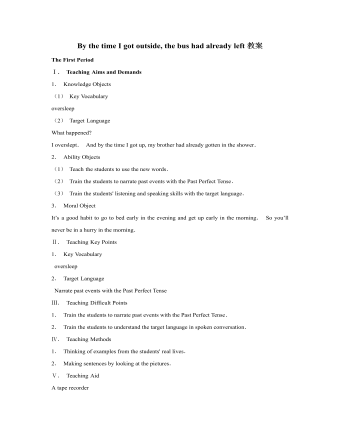
人教版新目标初中英语九年级下册By the time I got outside, the bus had already left教案
Ⅰ. Teaching Aims and Demands1. Knowledge Objects(1) Key Vocabularyoversleep(2) Target LanguageWhat happened?I overslept. And by the time I got up, my brother had already gotten in the shower.2. Ability Objects(1) Teach the students to use the new words.(2) Train the students to narrate past events with the Past Perfect Tense.(3) Train the students' listening and speaking skills with the target language.3. Moral ObjectIt’s a good habit to go to bed early in the evening and get up early in the morning. So you’ll never be in a hurry in the morning.Ⅱ. Teaching Key Points1. Key Vocabularyoversleep2. Target LanguageNarrate past events with the Past Perfect TenseⅢ. Teaching Difficult Points1. Train the students to narrate past events with the Past Perfect Tense.2. Train the students to understand the target language in spoken conversation.Ⅳ. Teaching Methods1. Thinking of examples from the students' real lives.2. Making sentences by looking at the pictures.Ⅴ. Teaching AidA tape recorderⅥ. Teaching ProceduresStep I Revision1. Revise the language points in Unit 8.Ask some questions like this: What volunteer work would you like to do?Help the students to answer, I’d like to…/I love to…/I hope to2. Practice the dialogue in Activity 3c on page 62 again. Get students to role play the similar dialogues with the following.
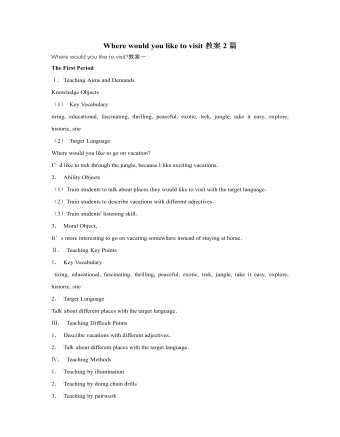
人教版新目标初中英语九年级上册Where would you like to visit教案2篇
The First PeriodⅠ.Teaching Aims and DemandsKnowledge Objects(1) Key Vocabularytiring, educational, fascinating, thrilling, peaceful, exotic, trek, jungle, take it easy, explore, historic, site(2) Target LanguageWhere would you like to go on vacation?I’d like to trek through the jungle, because I like exciting vacations.2. Ability Objects(1)Train students to talk about places they would like to visit with the target language.(2)Train students to describe vacations with different adjectives.(3)Train students' listening skill.3. Moral Object,It′s more interesting to go on vacating somewhere instead of staying at home.Ⅱ. Teaching Key Points1. Key Vocabularytiring, educational, fascinating, thrilling, peaceful, exotic, trek, jungle, take it easy, explore, historic, site2. Target LanguageTalk about different places with the target language.Ⅲ. Teaching Difficult Points1. Describe vacations with different adjectives.2. Talk about different places with the target language.Ⅳ. Teaching Methods1. Teaching by illumination2. Teaching by doing chain drills3. Teaching by pairworkⅤ. Teaching Aids1. A tape recorder2. Some pictures of different places with famous views
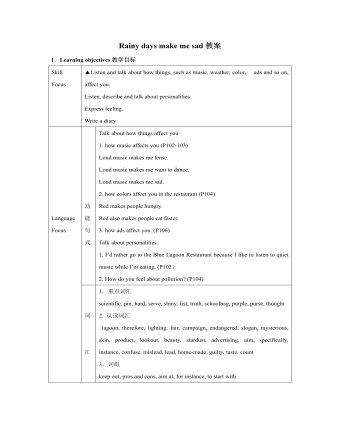
人教版新目标初中英语九年级下册Rainy days make me sad教案
1. 教材分析本单元以how do things affect you?为话题, 从颜色、天气、音乐、广告、产品等方面谈论了外界事物如何影响人的心情。要求学生掌握表达某物或某事给人带来的感觉、看法或影响等。共设计了四个部分的内容:Section A 该部分有4个模块:第一模块围绕Which restaurant would you like to go to?这一话题展开思维(1a)、听力(1b)、口语(1c)训练;第二模块围绕How does music affect you? 进行听力(2a-2b)、口语训练(2c);第三模块继续围绕how do colors in the restaurant affect you这一话题展开训练,训练形式为阅读和问题体验(3a)和小组活动(3b);第四模块仍就How do things affect you这一话题以调查的形式展开讨论。Section B该部分有4个模块:第一模块围绕产品广告对人们的影响这一话题以“配对”(1a)与“列举”(1b)两种形式展开训练;第二模块继续围绕How do things affect you? 进行听力(2a-2b)、口语对话训练(2c);第三模块围绕“Advertising”这一话题展开阅读(3a-3b)和写作(3c)训练;第四模块围绕How posters affect you这一话题以口语训练形式展开小组活动。
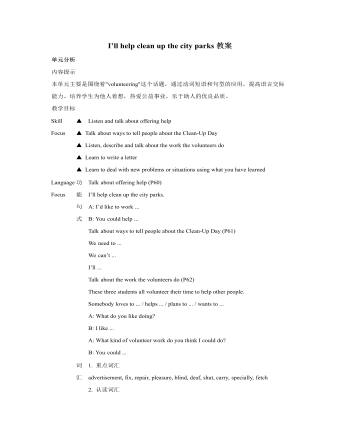
人教版新目标初中英语九年级下册I’ll help clean up the city parks教案
Talk about offering help (P60)I’ll help clean up the city parks.A: I’d like to work ...B: You could help ...Talk about ways to tell people about the Clean-Up Day (P61)We need to ...We can’t ...I’ll ...Talk about the work the volunteers do (P62)These three students all volunteer their time to help other people.Somebody loves to ... / helps ... / plans to ... / wants to ...A: What do you like doing?B: I like ... A: What kind of volunteer work do you think I could do?B: You could ...1. 重点词汇advertisement, fix, repair, pleasure, blind, deaf, shut, carry, specially, fetch2. 认读词汇hunger, homeless, cheer, clean-up, sign, establish, major, commitment, elementary, veterinarian, coach, similar, call-in, strategy, disabled, organization, unable, support, appreciate, donation, part of speech, pronoun, adverb, preposition, conjunction, donate, Jimmy, Sally3. 词组clean up, cheer up, give out, put off, set up, think up, take after, fix up, give away, put up, hand out, work out, at once
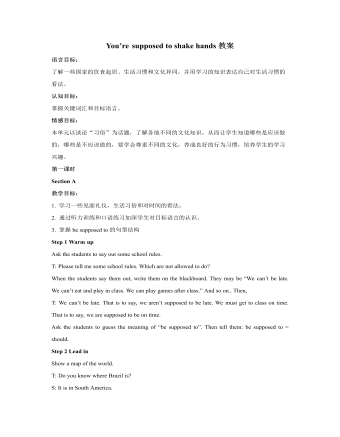
人教版新目标初中英语九年级下册You’re supposed to shake hands教案
教学目标:1. 掌握本单元一些重点词汇的写法和用法。2. 学会自如谈论餐桌礼仪。Step 1 RevisionAsk some students to retell the customs at the table in France in the passage in 3a.Step 2 Self checkPart 1. Fill in each bland with the correct word given. Students do the exercises by themselves at first. Then check the answers. Ask the students to comprehend the sentences and help them point out uses of some words, like “arrive (at / in) sw., spend time / money on sth , spend time / money (in) doing sth.”Part 2. Read about Fan Ling’s experience in a western restaurant. Understand the passage. Point out some key points in the passage.1. be / get used to doing sth. 习惯做某事2. begin with = start with 以….开头3. crowd v. 挤满,塞满 the crowd 人群 crowded adj. 拥挤的Then students discuss about how she would solve her problem. Ask some to share their stories with others.Part 3. Complete the crossword by looking at the sentences on the left. Then check the answers.
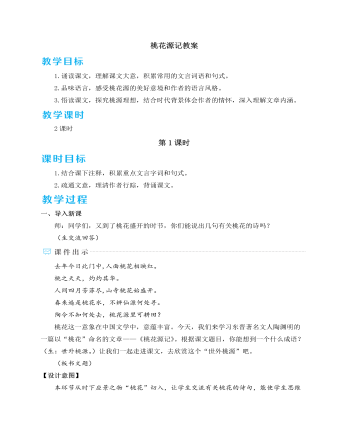
人教部编版语文八年级下册我一生中的重要抉择教案
五、总结存储1.教师总结这篇演讲词,作者用幽默诙谐的语言阐述了自己人生中的一个重要抉择——大力扶植年轻人。作者善于自我调侃,在自我解剖中进行了深入的分析,强调了扶植年轻人的重要性和必要性。演讲中列举了大量名人事例进行论证,使演讲具有很强的说服力。这篇演讲词展示了一位科学家精彩绝伦的语言魅力:不但有科学原理,而且有人生哲理;不但有学术的穿透力,而且有情感的震撼力;不但有理论的清晰度,而且有语言的幽默感——这一切构成了王选演讲的独特风采。我们在体会王选演讲魅力的同时,也领略到了他的人格魅力。2.布置作业(1)人的一生所做的重要抉择,如果与时代和国家紧密相连,意义会更加重大。我们在人生的关键阶段,如选择未来事业时,会做出怎样的抉择?请你写一段200字左右的演讲词,并在小组内演讲交流。(2)课外阅读王选的《我一生中的八个重要抉择》。
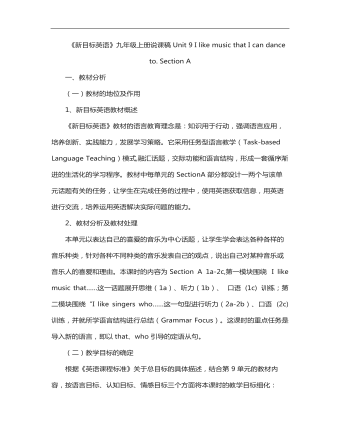
初中英语人教版九年级全册《Unit 9 I like music that I can dance to》说课稿
2、教材分析及教材处理本单元以表达自己的喜爱的音乐为中心话题,让学生学会表达各种各样的音乐种类,针对各种不同种类的音乐发表自己的观点,说出自己对某种音乐或音乐人的喜爱和理由。本课时的内容为Section A 1a-2c,第一模块围绕 I like music that……这一话题展开思维(1a)、听力(1b)、 口语 (1c) 训练;第二模块围绕“I like singers who……这一句型进行听力(2a-2b)、口语 (2c) 训练,并就所学语言结构进行总结(Grammar Focus)。这课时的重点任务是导入新的语言,即以that、who引导的定语从句。
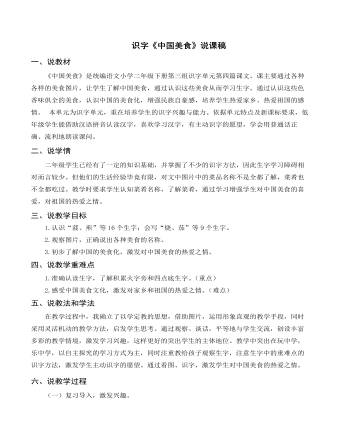
(说课稿)识字《中国美食》部编人教版二年级上册语文
一、说教材《中国美食》是统编语文小学二年级下册第三组识字单元第四篇课文。课主要通过各种各样的美食图片,让学生了解中国美食,通过认识这些美食从而学习生字。通过认识这些色香味俱全的美食,认识中国的美食化,增强民族自豪感,培养学生热爱家乡、热爱祖国的感情。 本单元为识字单元,重在培养学生的识字兴趣与能力。依据单元特点及新课标要求,低年级学生能借助汉语拼音认读汉字,喜欢学习汉字,有主动识字的愿望,学会用普通话正确、流利地朗读课问。二、说学情二年级学生已经有了一定的知识基础,并掌握了不少的识字方法,因此生字学习障碍相对而言较少。但他们的生活经验毕竟有限,对文中图片中的菜品名称不是全都了解,菜肴也不全都吃过。教学时要求学生认知菜肴名称,了解菜肴,通过学习增强学生对中国美食的喜爱,对祖国的热爱之情。
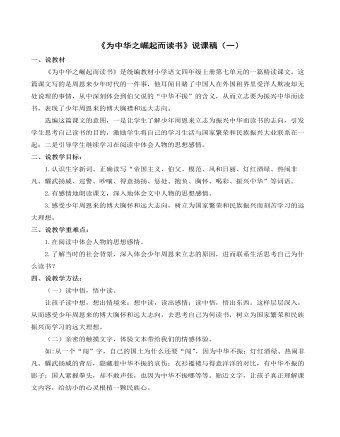
(新)部编人教版四年级上册《为中华之崛起而读书》说课稿(一)
1.初步探究,找切入点:我抛出问题:周恩来为什么会立下“为中华之崛起而读书”这一志向?文中的哪个词最能体现?这个词在文中出现几次?通过多个问题的设置,培养学生的理解能力,学生通过自己读课文,很快就能找出本文的关键词“中华不振”,在文中出现2次,进而引导学生划出句子。 2.比较阅读,交流发现:让生反复阅读两个句子,比较两处出现的“中华不振”有什么不同,然后在班上交流自己的发现,通过仔细比较阅读会发现:第一次的“中华不振”是由伯父告诉周恩来的,第二次的“中华不振”是由周恩来自己亲身体会到的。这一环节的设置,进一步激发学生的探索意识,让学生学会在阅读中进行比较分析,进一步的理解内容,体验情感。3.默读课文,交流感受:新课程标准指出:要让三四年级学生学会默读,做到不出声,不指读。通过让生默读课文,边读边感受:文中的哪些句子能让你感受到“中华不振”?划出相关句子,然后在班上交流感受,通过交流,有的同学会说:我从伯父的话语中能感受,有的会说:从妇女的哭诉中感受【这一环节的设置,通过让生读课文,找句子,谈感受,加深对“中华不振”的理解,更深入的体会当时周恩来的心情,理解周恩来立下志向的原因。
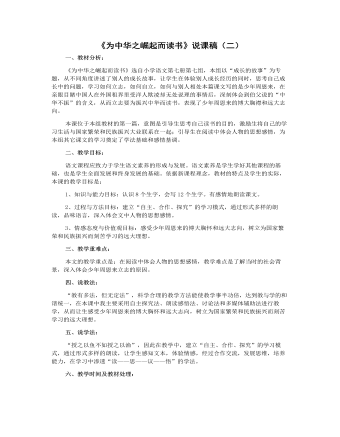
(新)部编人教版四年级上册《 为中华之崛起而读书》说课稿(二)
七、教学过程设计如下:(一)、创设情境,导课激趣1、孔子说过:“知之者不如好知者,好知者不如乐知者”,新课程标准也指出:语文教学要注意激发学生的学习兴趣。因此,在上课时,我充满激情的语言对学生说:同学们,有这样一个人,在飞机遇险的时候,不顾个人安危毅然把自己的伞包送给一个小女孩,你知道他是谁吗?有这样一个人,不仅全中国的人爱戴他,全世界的人也爱他,在他逝世的时候,联合国为他降半旗表哀悼之情,你知道他是谁吗?有这样一个人,他在12岁时就说出了一句令所有人都喝彩的一句话,你知道他是谁吗?【通过教师语言情境的创设,吸引学生的兴趣,自然引出本文课题“为中华之崛起而读书”】2、生齐读课题,谈谈你对课文题目的理解,师做点拨:“崛”是兴起的意思,“之”是“的”的意思。(二)、初读课文,整体感知1、借助汉语拼音朗读课文,提出自学要求
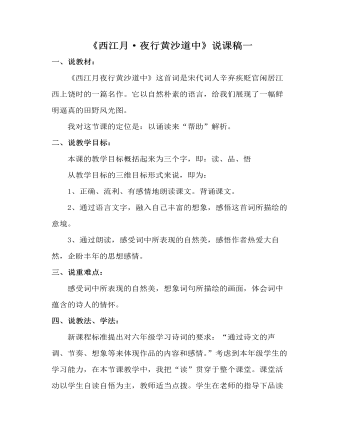
部编人教版六年级上册《古诗词三首:西江月·夜行黄沙道中》说课稿
一、说教材:《西江月夜行黄沙道中》这首词是宋代词人辛弃疾贬官闲居江西上饶时的一篇名作。它以自然朴素的语言,给我们展现了一幅鲜明逼真的田野风光图。我对这节课的定位是:以诵读来“帮助”解析。二、说教学目标:本课的教学目标概括起来为三个字,即:读、品、悟从教学目标的三维目标形式来说,即为:1、正确、流利、有感情地朗读课文。背诵课文。2、通过语言文字,融入自己丰富的想象,感悟这首词所描绘的意境。3、通过朗读,感受词中所表现的自然美,感悟作者热爱大自然,企盼丰年的思想感情。三、说重难点:感受词中所表现的自然美,想象词句所描绘的画面,体会词中蕴含的诗人的情怀。四、说教法、学法:新课程标准提出对六年级学习诗词的要求:“通过诗文的声调、节奏、想象等来体现作品的内容和感情。”考虑到本年级学生的学习能力,在本节课教学中,我把“读”贯穿于整个课堂。
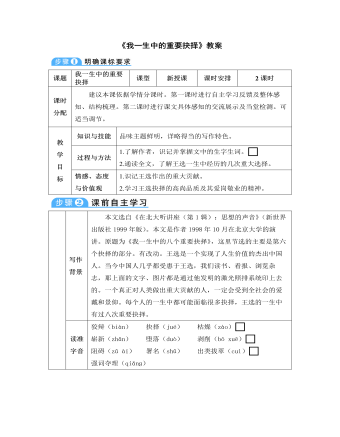
部编版语文八年级下册《我一生中的重要抉择》教案
(1)一个快落山的太阳,跟大家讲的,更多的是自己一生奋斗过来的体会。指61岁的老人。(2)加入人家说我是权威,也许还马马虎虎。作者自谦的说法,指成绩还过得去。(3)明明是一个过去时态,大家误认为是现在时态。指作者认为自己不适合再做权威了。(4)扶植年轻人我觉得是一种历史的潮流,当然我们要创造条件,就是把他们推到需要刺激的风口浪尖上。比喻重要的岗位或市场的前沿。【感悟精彩句子】1.所以我知道自己是一个下午四五点钟的太阳。各位呢,上午八九点钟的太阳,这是本科生;硕士生呢,九十点钟的太阳;博士生呢,十点十一点钟的太阳。比喻,拉近了与听众的距离,倍感亲切、期望和鼓舞。2.所以1992年前电视台采访我,我基本上都拒绝了。透过细节,体现了坚持不懈的科研精神。
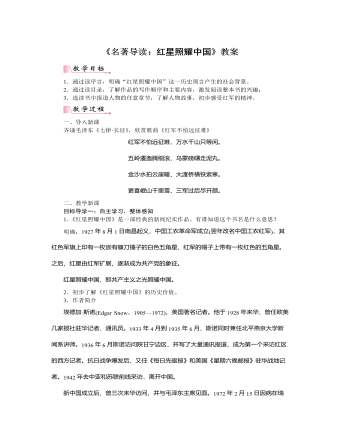
部编版语文八年级上册《名著导读:红星照耀中国》教案
读序言,可以了解内容概要、写作缘由和过程,明确写书的纲领和目的。学生活动一:用5分钟时间浏览一篇序言(译者序和作者序任挑一篇),运用跳读法采集信息点,记录在便利贴上。并互动交流。小结:序言告知我们,“红星照耀中国”是作者在中国及世界局势即将发生大转变的关键一年,冒险来到西北红色区域采访后得出的结论。那么他在苏区见到了什么,听到了什么呢?让我们把视线焦点集中到他笔下那一群“不可征服”的革命青年身上。(二)读目录,了解主要内容及写作顺序1.学生浏览目录,说一说,这本书的写作顺序是怎么样的?主要写了哪几方面的内容?【方法指导】读目录,可以对作品的内容要点和篇章结构有所了解,迅速查阅到所需要的部分。明确:《红星照耀中国》是一部文笔优美的纪实性很强的报道性作品。作者按照事件发生的自然时间顺序真实记录了自1936年6月至10月在我国西北革命根据地进行实地采访的所见所闻。该书绝大部分素材来自作者采访的第一手资料,向全世界真实报道了中国和中国工农红军以及许多红军领袖、红军将领的情况。
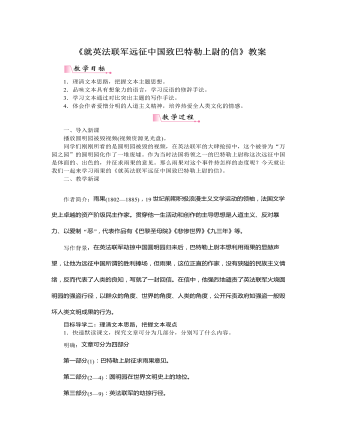
部编版语文九年级上册《就英法联军远征中国致巴特勒上尉的信》教案
3.作者是如何表达出自己的观点的?明确:作者首先以瑰丽的语言盛赞圆明园在人类文明中的地位,其后,又以比喻及反讽的修辞,将英法联军劫掠圆明园的罪行揭露而出,两者形成鲜明的对比,从而引出谴责英法联军远征中国行为的观点。目标导学三:了解作者心中的圆明园及英法联军的强盗行径1.作者是如何描述他心目中的圆明园的?明确:圆明园是幻想的某种规模巨大的典范,一座言语无法形容的建筑,某种恍若月宫的建筑。作者用大理石,玉石,青铜,瓷器,雪松,宝石,绸缎,神殿,后宫,城楼,神像,异兽,琉璃,珐琅,黄金,脂粉,一座座花园,一方方水池,一眼眼喷泉,成群的天鹅、朱鹭和孔雀等无数华贵的象征,铺就了一张华贵的想象画面,构成他心中的圆明园。正如他所说“总而言之,请你假设人类幻想的某种令人眼花缭乱的洞府,其外观是神庙,是宫殿,那就是这座园林”。
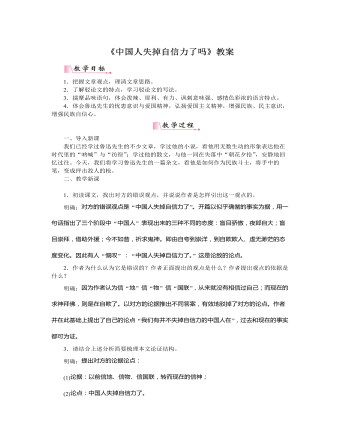
部编版语文九年级上册《中国人失掉自信力了吗》教案
一、导入新课我们已经学过鲁迅先生的不少文章,学过他的小说,看他用无数生动的形象表达他在时代里的“呐喊”与“彷徨”;学过他的散文,与他一同在失落中“朝花夕拾”,安静地回忆过往。今天,我们将学习鲁迅先生的一篇杂文,看他是如何作为民族斗士,将手中的笔,变成抨击敌人的枪。二、教学新课目标导学一:学习驳论,理清思路1.初读课文,找出对方的错误观点,并说说作者是怎样引出这一观点的。明确:对方的错误观点是“中国人失掉自信力了”。开篇以似乎确凿的事实为据,用一句话指出了三个阶段中“中国人”表现出来的三种不同的态度:盲目骄傲,夜郎自大;盲目崇拜,借助外援;今不如昔,祈求鬼神。即由自夸到崇洋,到自欺欺人、虚无渺茫的态度变化。因此有人“慨叹”:“中国人失掉自信力了。”这是论敌的论点。


